Exams and Tests: Guide to Preparation and Simulation of TOEFL
NOTE: I HAVE INCLUDED NOTES ON THE IMPORTANT CHANGES TO SPEAKING MADE IN 2020. YOU SHOULD BE AWARE OF THIS IF YOU HAVE OLDER MATERIAL INCLUDING SOFTWARE.
The TOEFL test is an entirely computer-based English language exam. Luckily there are many free resources online and you can get TOEFL exam simulation software to help you prepare. I have taught the TOEFL test to students since 2014 and my guide gives you tips and strategies for all sections but I mainly concentrate on speaking and writing.
The TOEFL exam has a different structure to the IELTS test and requires more practice. If you decide “I am going to do the TOEFL exam tomorrow.” you probably won’t do very well as the exam is very different to a traditional exam like you do in school, or like the IELTS test.
It requires a different way of thinking, however, I think it is a brilliant way to test your English and to prepare you for studying abroad, although maybe students don’t want to hear this, they just want a good score as easily as possible!
First, a couple of things about the TOEFL exam that are usually a surprise for students:
- The exam is entirely computer-based, including the speaking.
- For the speaking part, you wear a headset and listen to questions and then speak into a microphone. You are not in a room with an examiner like in IELTS.

- The entire exam usually takes place in a large room with desks. Your elbows could almost be touching the people beside you!
- There could be 5, 10, 15, 20 or more students in the room doing the exam at the same time. My God!
- That means you might hear other people doing the speaking part, they will be speaking out loud answering their questions while you are listening to your question and preparing to speak and answer it. This news can be a shock to students, so it is important to know this at the beginning.
- The writing, listening, speaking and reading are all worth 30 marks giving you a total of 120 for the entire exam.
- It is a good idea to study American college vocabulary, you can find some examples here and with some googling you can find more. They talk about papers, my major, professor instead of lecturer etc which is used in British English.
My teaching method is similar to IELTS which you can read here, I don’t teach the reading and listening parts in class. You study these yourself at home by practising exam questions. As the exam takes place totally on a computer you can buy software to practice the exam.
ELS, the organisation that runs TOEFL produce their own guides but many of the options available are made by companies that want to make money from the TOEFL exam, they are not produced by ELS.
However, ELS do have some great resources on their website including sample questions here and YouTube channel.
Some of this software is better than others and there are a few options for you. One piece of software is produced by Cambridge and I believe that it most accurately simulates the exam in its look and functionality.
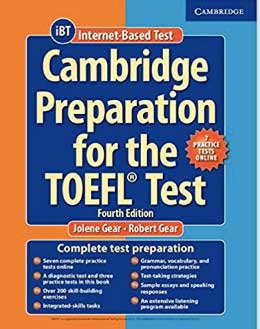
There are many nice features on it, such as:
- You can choose to show if an answer is right or wrong to help you, or not display anything.
- You can choose to show you what the correct answer is or not.
- Choose to show your score at the top or not.
- You can return to questions you have already done so you can check your answers, like in the exam.
- Amazingly, well to me anyway, it also records audio of you speaking when you practice the speaking section. But it does not give your recorded answer a score, but there are online services that do this.
Back to this book and software by ETS, the official TOEFL exam people.
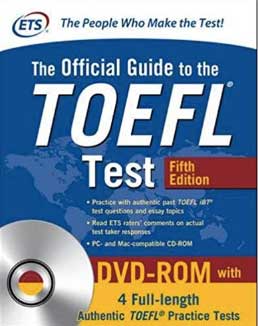
I haven’t used the software but I don’t recommend the book as it describes what the exam looks like which is not efficient. If you want to learn how to drive, do you read a 747-page book, or do you get into a car and learn? Like many things you learn by doing. It contains 4 authentic exams which is good, the Cambridge one has 7 exams but they are not official.
My articles here are probably all you need to know, you don’t really need to read 747 pages. Any questions you have your teacher should be able to help you.
The software does not correct your speaking, that really would be some sci-fi [science-fiction] level programming, but there is an option to send your audio files to a teacher have them corrected.
However, I believe your English teacher should be able to give you good guidance on what score you would get.
If you want to learn more about how to get your TOEFL exam score, the TOEFL test speaking scoring metric is here and the writing scoring metric is here. Like the IELTS exam metrics here, it is quite complicated at first, even to experienced teachers of English.
With practice you learn what level you are at and there are lots of unofficial scores online that you can research. People put videos on YouTube, write on their blogs, and there are podcasts discussing the TOEFL test. You need to use your own judgement to discover what score you receive, but with practice you can be pretty accurate.
The Baron software looks like this:
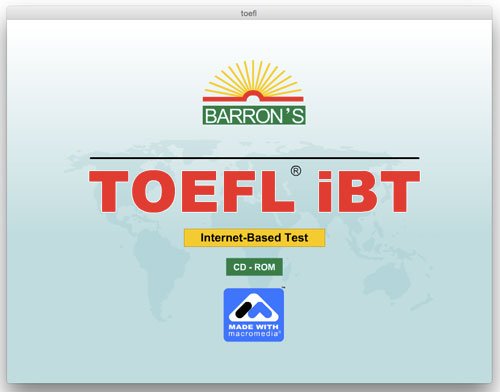
The version I have is from 2006 and it is very similar to Cambridge but is not as well designed. For example:
- You can’t skip the instructions to each question, after you hear the instructions 3 or 4 times you know what they are but you must listen to them here every time, very annoying in class when you want to make the best use of your time with your teacher. You can skip them in the Cambridge software.
- The questions also have a slightly different structure to the Cambridge software, I believe that the Cambridge one is more similar to the actual exam but it’s good to practice the slightly different questions so you don’t get surprised by a strange question in the actual exam.
- It also doesn’t record your speaking. But it’s still good to have another 7 exams to practice.
Tips and Strategies for TOEFL Exam Speaking
2020 CHANGES
- Before the 2020 changes the speaking section had 6 questions, each worth 5 points/marks giving a total a 30. If you have older material such as books or software then they may use this format.
- The changes made were that now there is only one personal opinion question at the start fo the test, there used to be 2. You also won’t be asked about “advantages/disadvantages” in this new question one.
- The other change is that question 5 about a campus situation has been removed. I have still included my information on it as you might have the older/software material.
- In general this was often the most difficult question on the test. The audio was long and they deliberately set “traps” that students fell into. The main trap was that you must answer the question that was asked, not what you think was asked. The usually asked you for specific information int he audio and many students summarised the entire audio and then they would get a lower score.
- Overall I believe that removing this question5 makes the speaking section easier and less stressful.
- If you have the older material, then individual students can decide if they want to continue answering question 5 for more practice or ignore it.
Overview:
- However the total score remains the same, you receive a score out of 30.
- The usual mark required to study abroad in a university that teaches through English is around 80, but as stated here in my post on the difference between IELTS and TOEFL you must check each individual course for their requirements.
In the speaking, the recording of your answer used to be corrected by between 3 and 6 people, I see on the official site they now say “multiple, highly trained human raters”.
Both Baron and Cambridge software have the option to make the exact transcript of the question appear and disappear on screen to help you when you correct your answers.
As a test for what you will actually experience when you study abroad, I believe that the TOEFL exam is excellent. The designers of the exam have clearly thought about what students experience when they study abroad and this exam tests those skills.
The designers are not stuck in the traditional “we have always done it this way” thinking and setting an exam that doesn’t actually reflect what you will be doing, like a traditional language exam in secondary school or high school.
However this doesn’t necessarily mean it is better or easier for students to get a good score, but it does help prepare them for what they will experience when they study abroad.
Let me show you what I mean using the Cambridge TOEFL simulation software:
Remember this is my pre-2020 software before the changes were made to speaking reducing the number of questions from 6 to 4.
Before you start the Speaking exam:
- At first you answer a question “Describe the city you live in:”
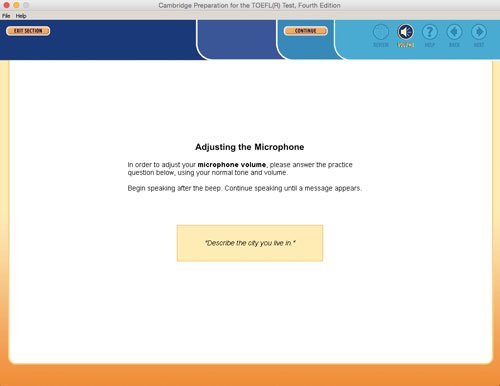
- This happens in the exam too in order to test that the microphone works on your headset and that you are loud enough so that the examiner can correct your answer.
Then the exam itself starts.
Questions 1
Before 2020 questions 1 and 2 are designed to be the easiest, they are questions to warm you up and help you build your confidence. Now there is just 1 question.
- It is an opinion question so there is no right or wrong answer.
- Later questions you DO need to get the answer ‘correct’ to get full marks.
- You listen to the question, which also is in text on your screen and you have 15 seconds to prepare and 45 seconds to speak.
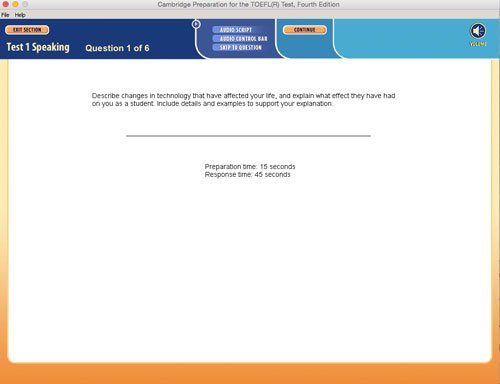
You MUST:
- Speak clearly and not too quickly.
- Make the fewest errors possible.
- Show your range of vocabulary.
- Show your ability to use complicated verb tenses.
- Express your thoughts and ideas clearly.
You MUST NOT:
- Freeze, that means not saying anything at all.
- Only speak for 20 or 30 seconds instead of 45. This is bad but it is a common problem that you can solve with practice.
Questions 2-4
For questions 2 to 4 you must answer the question ‘correctly’, if you do not give the correct answer, even if your English is perfect you will not achieve the highest score.
Question 2
- What is now question2, used to be question 3 before the 2020 changes. It is always about a campus situation, for example, problems with parking on campus, accommodation, working as a student, maybe a personal problem such as a student needing to miss a class for some reason, events on campus etc.
- There are 2 speakers, a man and woman to make it easier when answering the question. You can say “the woman” or “the man” and not “speaker 1” or “speaker 2”.
- First, you read some text about the campus situation as an introduction.
- You have 45 seconds to read the text and there is a timer in the top right corner of the screen
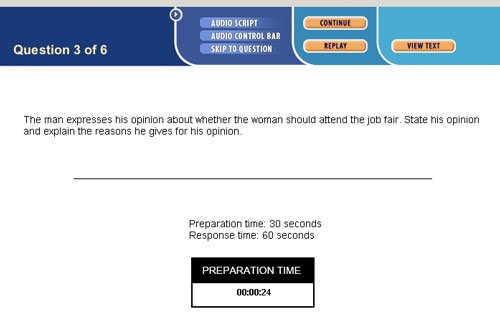
- You can make notes if you like, I recommend you do, because after 45 seconds the text disappears and you CAN’T read it again.
- In general, and I stress in general but not always, the answer to the question is in the audio.
- But sometimes part of the answer might only be in the text. So if you do not read the entire text in 45 seconds you might miss out on some information and then you cannot answer the question ‘correctly’ and lose marks.
- Then you listen to the audio conversation of around 30/45 seconds.
- You can and should make notes and I think the best strategy is to draw a line down the middle of your page and make notes about what the man says (M) and the woman says (W), like this:

- You have 30 seconds to prepare and 60 seconds to speak.
- The question is usually discuss the problem, then something like talk about which solution you prefer.
- You need to be very careful with the question. If they say “state which solution you prefer and why” in this case you do NOT discuss both solutions, you just state one and say why. The natural thing to do is to discuss both, you are now answering the question incorrectly and will receive a lower score. You also will not have enough time to answer everything if you do this.
- This is a very common mistake that you can solve with practice.
Question 3
Question 3 has the same structure as question 2. This was question 4 on material before the 2020 changes.
- You read some text for 45 seconds and then listen to 1 person speaking for about 45 seconds.
- However, it is on an academic subject such as engineering, science, psychology, biology etc.
- There might be technical English specifically related to the topic which might be difficult.
- However, you could be lucky and it might be a topic you already know a lot about.
- You will usually need to discuss both the reading and the listening part.
- You have 30 seconds to prepare and 60 seconds to speak.
- I recommend taking notes during both reading and listening. With practice you will know what notes or words to write down.
Summary 2 & 3
You can see how these questions prepare you for studying abroad, you read a text, then listen to audio, then you have to process this information and give the information back through speaking. Just like you would in a lecture while you are studying.
You can also see that the questions are getting gradually more difficult.
PRE 2020 Question 5
NOTE: This question is no longer on the exam. I have included in case you have older material.
Question 5 used to be very tricky:
- There are deliberate traps in the question to try to get you to make a mistake.
- It is very easy to answer the question ‘incorrectly’ and lose a lot of marks.
- However after practicing the question a few times in class with your teacher you will be able to recognise these traps and avoid them.
- There isn’t any text to read, only audio to listen to.
- The audio is longer than in question 2 and 3 at around 1 minute.
- It always features a man and woman speaking so it is a good idea to write the columns as before like this:

- The structure is usually that one person has a problem at university, they discuss it and some possible solutions.
- If they ask you about the man, you answer about the man, you don’t mention anything about what the woman says.
- Or, for example, if they ask you about the woman’s problem, then you don’t discuss the man’s solution.
- If they say state, you state briefly.
- If they say discuss, you talk more.
- You need to be aware of the time you have to speak. The answer will be quite long and a trap is that you don’t have enough time to say what you want.
- There will be 2 parts to the question, and with practice you will know how long to speak for each part:
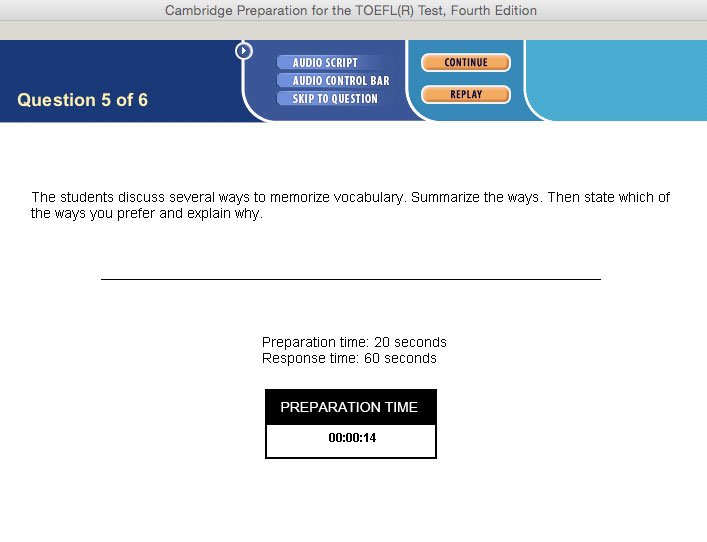
- Here you can see that the answer to the first question “Summarize the ways.” is long, then the second part “Then state which of the ways you prefer and explain why.” is shorter.
- So I would speak for around 45 seconds for part 1 and 15 seconds for part 2.
- But if you feel that you have answered the question in 40 seconds then great!
- The important thing is that with 15 seconds remaining, you start speaking about the 2nd part. Do not spend any more time on part 1.
- A common problem is only having 5 seconds to speak about part 2, or worse no time at all which means you will lose a lot of marks.
You can see that this question could cause students problems and you will probably be happy that it has been removed!
Question 4
Question 4, or the old question 6 is difficult.
There is nothing else to say. There is no text to read, just audio.
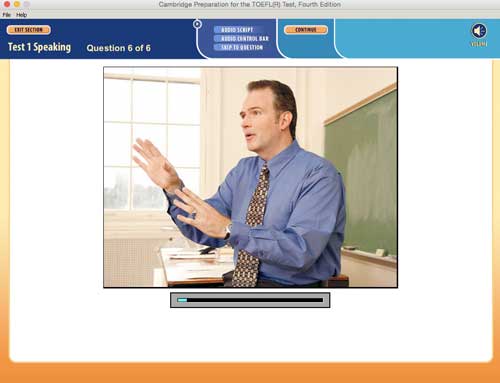
First, let’s look at the bad news:
- The audio will be about a complex academic topic.
- Most students feel that the speaker speaks very quickly.
- The topic could be civil engineering, sociology, biology, psychology, history, education etc almost anything really.
- There will be a lot of technical terms related to that topic. Even as a native speaker and a teacher I have heard lots of technical English that I had never heard of before.
And now the good news:
- It is always just one speaker, never 2. This is because it is meant to simulate a lecture at university.
- 90% of the time the question is the same “Summarize the points you heard in the lecture.”
- You could be lucky and the topic could be something you know a lot about or are studying yourself.
- 90% of the time you don’t have to worry about getting the question right or wrong as the question is always the same.
- In only 1 of the 14 tests in the Cambridge/Baron software I have used is there a different question. It surprised my students and it referred to a specific part of the lecture. So if you didn’t answer that part correctly, I think that you would receive a lower score.
However, I think this was an exception, so in general, you simply repeat as much as you can of what the lecturer says.
My advice:
- Write notes when listening.
- What notes should you write? That is entirely up to you, you can only find out what works and doesn’t work for you with practice.
- In general I would write down single keywords that you hear and then be ready to talk about them.
- You don’t need to write sentences.
- You prepare for 20 seconds and then you must talk for 60 seconds.
- If you can keep talking for the entire 60 seconds then well done! You should be proud.
This question is designed to separate the really good students from the rest:
- Often weaker students can only talk for 10 seconds and say a couple of sentences and they might get a lower score.
- The stronger students will talk for the entire 60 seconds and so they could get higher one.
- Remember you don’t need to be 100% perfect to get the top mark.
Also, this question is worth the same number of marks as question 1 where you speak for 45 seconds and give your opinion.
However, this question prepares you for life studying abroad through English. You listen to lectures, you understand, then you can give that information back to your classmates or in your coursework.
This makes TOEFL a very interesting exam, it is preparing you for student life, not just testing your level of English.
Tips and Strategies for the TOEFL Writing Exam
Again the writing section is designed to simulate studying abroad.
There are 2 questions.
Question 1
Question 1 has a similar structure to the speaking.
- First, you read a text for 3 minutes.
- You don’t need to make notes on paper because unlike the speaking questions 3 and 4 the text reappears when you start to answer the question.
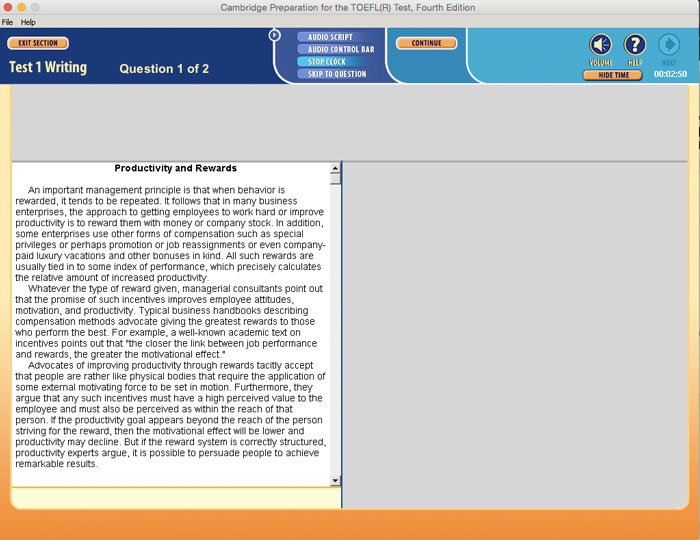
- Then you listen to someone speaking on the same topic for about 50 seconds.
- Then the good news here is that the question is almost always [We can never say 100% of the time] the same.
“Explain how they [the speaker] casts doubt on the points made in the lecture.”
There is a very clear strategy on how to answer the question correctly here.
The text will have 3 clear points. You will usually see them in the text as each point will be a separate paragraph as in the image above.
Then the speaker will present a counter argument on each of these 3 points. Essentially “The text says X but sometimes X is not true and in fact Y is true”. The speaker will do this for all 3 points.
You have 20 minutes to answer the question.
A good answer will have:
- An introduction, which will be 1 or 2 sentences summarising the differences.
- Then one short paragraph showing how each point in the audio is different to the text. And that’s it!
- You don’t need to write a conclusion.
- You should start each paragraph you write with the audio then you write about the counterpoint made in the text.
- Do NOT start explaining what is in the text first.
- The reason for this is the text is on the screen in front of you, you will not get a good score writing about this text!
As always when you start these exams:
- Timing is not important.
- You concentrate on structure, and getting the answer right, with good English.
- Then try speeding up 1 or 2 weeks before the exam.
On the official TOEFL website, you can download pdf’s and they give the answers see here, download volumes 3 and 4, you can ignore volumes 1 and 2, you can see the Chevalier article in volume 3 here:
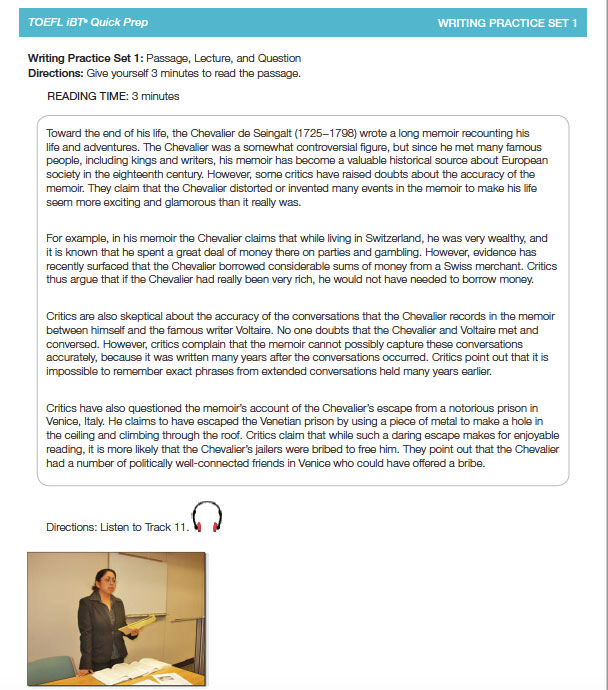
They then give you the points that a correct sample answer will have, which is the 3 points from the text and the counter arguments made in the audio:
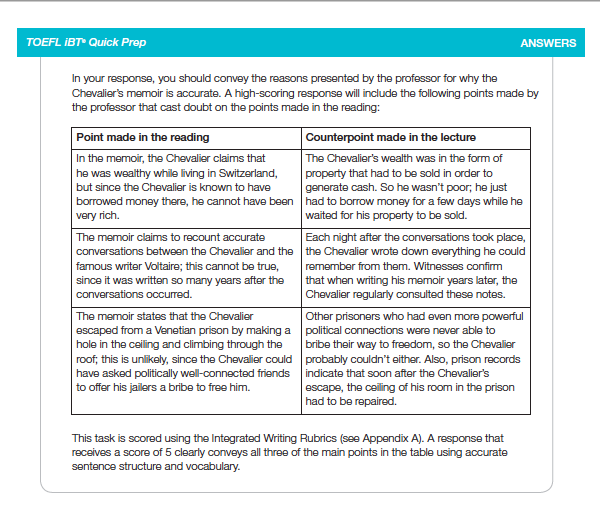
This is coming directly from ETS, the TOEFL exam people, so it is important to remember.
So you can see that this type of question is very different from anything you have done before but it does prepare you for student life.
However, question 2 is more traditional.
TOEFL Exam Writing Question 2
They will have a statement and you give your opinion on it.
You can see an example here:
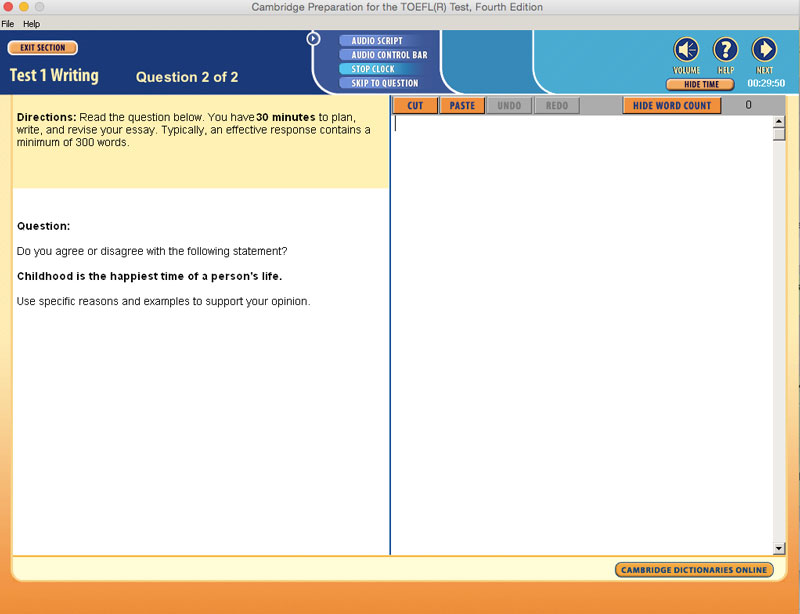
- You have 30 minutes. The timer is top right of your screen.
- It says a minimum of 300 words.
- It is important you write at least 300 words, 295 is bad, 305 is good.
- In general around 320 is fine, 330 is a bit long and 340 or more is too long.
- They want 300 words so you give them 300 words. If they wanted 340 words they would ask for 340 words.
- Writing those extra 40 words means you have spent time writing instead of correcting your writing and eliminating your errors.
Structure
- An opening paragraph.
- 3 or 4 paragraphs as the main body of your essay.
- Each paragraph is a separate point.
- A summary/conclusion paragraph, avoid copying your opening paragraph.
- As always don’t worry about time at the start, focus on structure, eliminating mistakes etc.
- A common problem is students not knowing what to say, in fact many say they think it would be difficult to write the essay in their native language, so writing it is English is even more difficult.
This question is more like a traditional exam question that you are accustomed to doing in school or college.
ETS used to have an essential resource of sample writing responses for both question 1 and question 2. They give an example of an answer that receives the top score of 5 and an explanation why it receives this score, an answer at level 4 and why, some answers at level 3 and why etc. So when you read many good and bad answers you can understand what will get you the best score. The old link I had is dead so you try and get it from here.
And that is my guide to the TOEFL exam, if you would like to know the difference between TOEFL and IELTS tests you can read my post here, I have also written a guide to the IELTS exam here.
If you are a Portuguese speaker and are making mistakes then you can read more about my specialist books here.
You might also be interested in our video course on sale on Udemy for €29.99/69.99R$ “Eliminate the Mistakes that Portuguese Speakers Make in English”. 4 hours of video exclusively for people that speak Portuguese. You can read more about it and watch free videos here.
Or if you are planning to study abroad, then discover here english schools in Dublin.
I have taught TOEFL and IELTS since 2014 and I am still available to teach it over Skype/FaceTime etc, you can read more about my classes here.
You can also check here my reviews of the TOEFL Exam Simulation Software or read about how to put your English level on your CV/Resume in here.
Do you have any tips for TOEFL? You can leave a comment below. Also feel free to share this post with anyone thinking about TOEFL!
